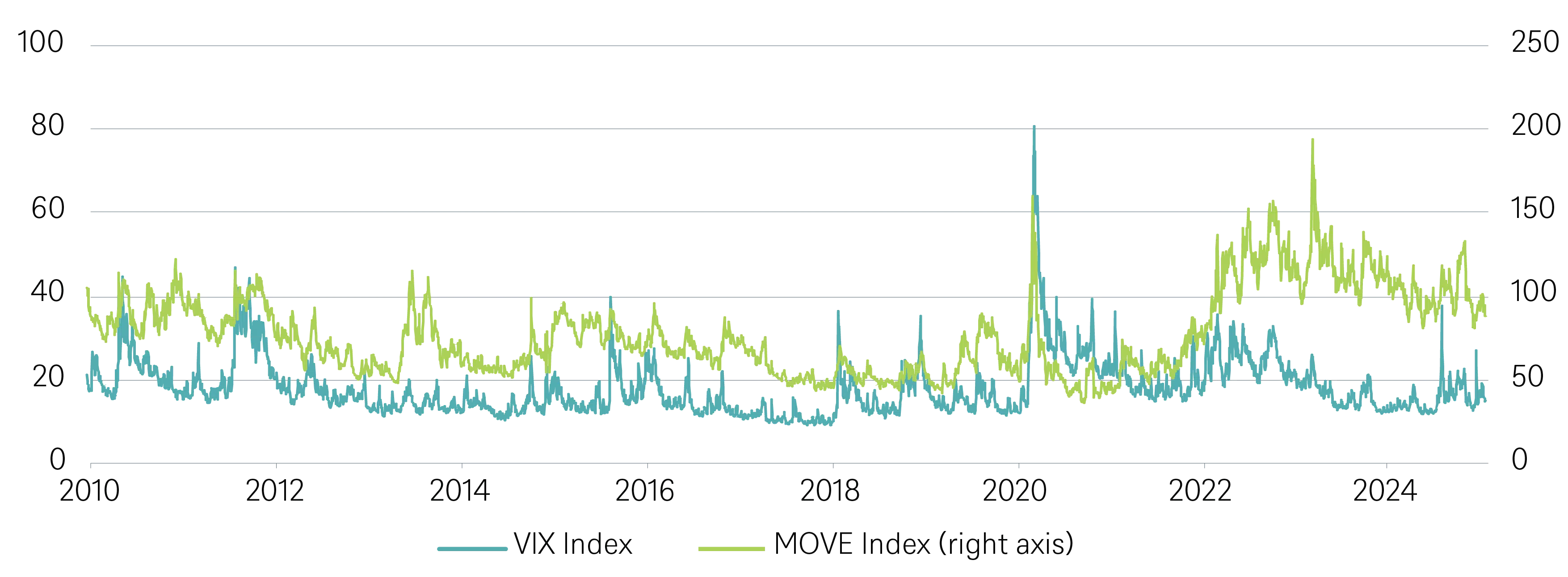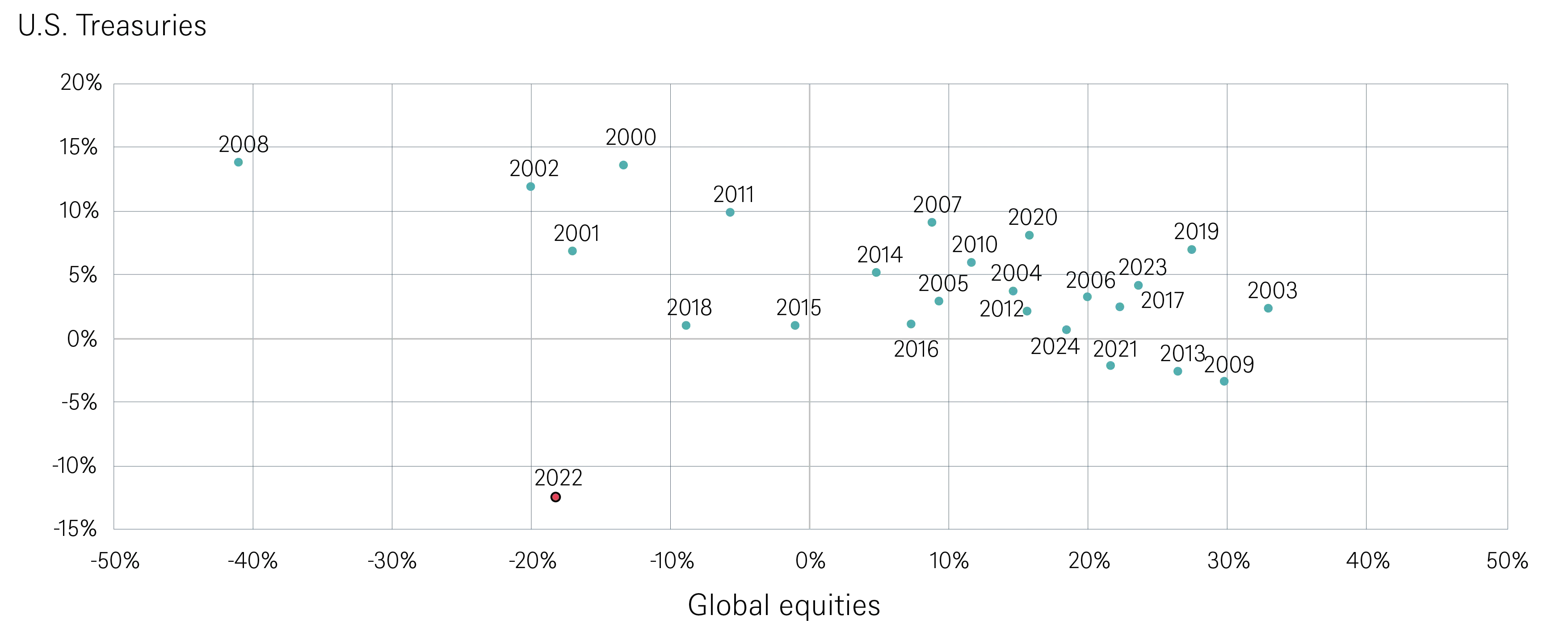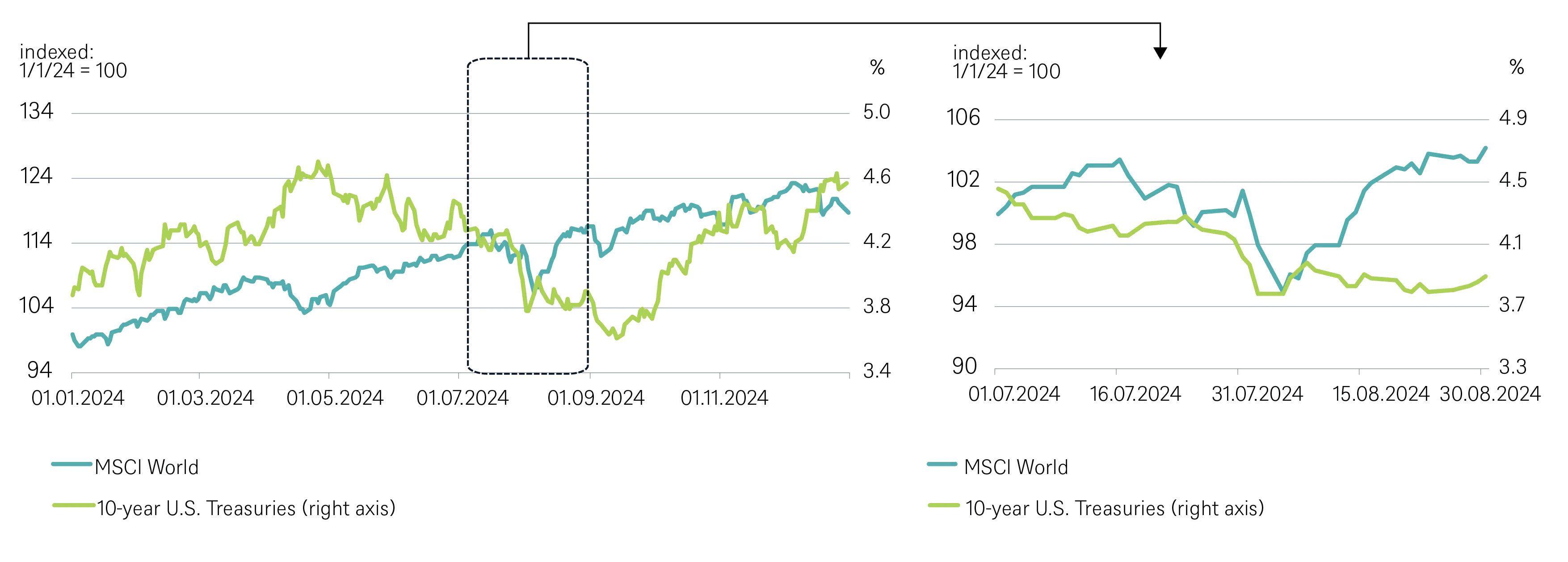Warning – attempted fraud
We have detected that fraudulent individuals are misusing the "DWS" trademark and the names of DWS employees on the internet and social media. These fraudsters are operating fake websites, Facebook pages, WhatsApp groups and Mobile Apps. Please be aware that DWS does not have any Facebook Ambassador profiles or WhatsApp chats. If you receive any unexpected calls, messages, or emails claiming to be from DWS, exercise caution and do not make any payments or disclose personal information. We encourage you to report any suspicious activity to info@dws.com, including any relevant documents and the original fraudulent email. Additionally, if you believe you have been a victim of fraud, please notify your local authorities and take steps to protect yourself.
3/2/2025
After years of minimal interest rates, investors have been piling into money-market funds since 2022 to take advantage of higher rates. Now is the time to rebalance and diversify.

After years of dormancy, money-market funds have awakened with a surge over the past three years: since the beginning of 2022, some EUR 1,900 billion have flowed into money-market funds globally, an increase of 30.4%. Funds in other asset classes suffered, especially balanced funds (see chart). However, due to the turnaround in interest rates and the heightened economic and political uncertainty following the U.S. elections in our opinion it is the right time to diversify again.
Global fund-industry inflows from January 2022 to November 2024

In % of assets under management compared to January 1, 2022, measured using global Morningstar categories. Sources: DWS Investment GmbH, Morningstar, as of 1/1/25
As a result of the (ECB’s) tightening between 2022 and 2024, the return of interest rates led to strong demand in money-market-related solutions, which now offer yields of more than 4% per year. In addition to the attractive interest rates, private investors in particular, were furthermore convinced by the asset class's historically low and high .
With the exception of Japan, the world's major central banks have embarked on an easing cycle, which has led to leaving money-market interest-rate peaks behind us. The ECB, for example, has cut its deposit rate four times in the past year, by 25 each time, to its current level of three percent. We expect four more cuts this year, in line with the market, to two percent (see chart). And that may not be the end of the story. By 2026, sluggish economic growth in Europe could push rates as low as 1.5%.
Current interest-rate cycle and market expectations in the
Sources: DWS Investment GmbH, Bloomberg Finance L.P., as of 1/1/25
In our view, this means that investors in money-market funds are exposed to significant reinvestment risk over the next year or two, as money-market-fund rates track policy rates closely. Historically, there is another problem with money-market funds for long-term investors: their performance has lagged that of many other asset classes over a full cycle, [1] and in many periods they have not even managed to preserve their capital in terms. Such a period may be coming again; after all, the capital market is currently pricing in long-term of just over two percent per year.[2]
Equities, on the other hand, have historically shown to be an inflation hedge, and we believe that they are the way to go for real asset growth in the future. However, even broadly diversified global equity investments are subject to greater volatility. During the, at times we saw losses of more than half of the invested capital. An all-equity investment may therefore be outside of some investors’ risk tolerance.
So, simply buy bonds, be they government or corporate, and even benefit from falling interest rates and the associated price increases? In the following, we will show that an appropriate mix of asset classes, from money-market-related investments to bonds and equities, is crucial for successfully navigating the uncertain waters of the capital markets. We will discuss the benefits of combining different asset classes and managing risk factors. Diversifying across and within asset classes is not only relevant, but also seems possible now.
The era of low interest rates has come to an end by 2022 at the latest: as inflation rates have risen around the world, central banks have been forced to raise interest rates again. The resulting rise in yields has led to a significant drop in bond prices,[3] but also to the long-awaited return of attractive yield opportunities across the bond spectrum (see chart). Depending on credit quality, corporate bonds, for example, are now yielding between three and eight percent per year.[4]
Sources: DWS Investment GmbH, Bloomberg Finance L.P., as of 1/1/25
These higher yields can cushion short-term price declines and thus provide a certain safety buffer. If you lock in a yield of 5.0% per year to maturity today, you should be able to withstand major movements in interest rates better than an investor who buys at 0.5% per year. This means that investors in U.S. bonds can tolerate a rise in yield three times higher than in the beginning of 2022 before they have to book losses on their bonds. This also makes the question of the optimal entry point somewhat less relevant.
In addition to their role as a source of income, bonds have another role to play in investing: they act as a stabilizer, historically fluctuating up to three times less than stocks. But are they currently living up to this stabilizing role?
Historically, bonds have been a less volatile asset class through many periods, and including them in a portfolio seems reasonable, if not necessary, depending on the overall risk profile. However, if you look at the current implied volatility of these asset classes, you can see that while the risk priced into equities has come down significantly, the uncertainty in the bond market remains above the historical average of the last decade (see chart). This is partly due to the current uncertainties about growth, inflation and monetary policy, but also to the deterioration in government debt ratios with negative balances. Equity investors seem to be less concerned about the resulting risks than bond investors.
Implied stock and bond volatility since 2010

Sources: DWS Investment GmbH, Bloomberg Finance L.P., as of 1/1/25
This sentiment among market participants is reflected in the current record highs. U.S. equities in particular have risen sharply again in 2024. This entails a continued high concentration of the stock market in the U.S., especially in a few companies. Valuations of many companies have increased again, buoyed by AI and the prospect of a more business-friendly U.S. administration. While short-term setbacks cannot be ruled out, we believe that the idea of participating in innovation and earnings growth argues for a long-term equity allocation. However, even a global, broadly diversified investment in the equity market is subject to greater market volatility and carries downside risks that may not be acceptable to investors.
To achieve more stable returns in different market phases, we believe it is essential to combine both asset classes in a portfolio. However, many investors still think of 2022, when this diversification did not work - both equity and bond prices fell. Over the past 25 years, however, bonds have almost always been a stabilizing factor for a stock/bond portfolio.
Performance of equities and bonds over the last 25 calendar years

Sources: DWS Investment GmbH, Bloomberg Finance L.P., as of 1/1/25
In our view, bonds should therefore be included as a stabilizing element in portfolio construction. Especially since the usual interplay between stocks and bonds is returning to a somewhat normal level as inflation rates fall and monetary policy is loosened. This was particularly evident in the middle of last year. While equity indices posted significant losses in August, government bonds benefited from falling yields (see chart). In such a market situation, driven primarily by growth concerns, a mixed portfolio can benefit from diversification effects.
MSCI World performance vs. 10-year U.S. Treasury yield in 2024

Sources: DWS Investment GmbH, Bloomberg Finance L.P., as of 1/1/25
Just looking at the last three years shows how the correlation can change over time, which is consistent with the longer-term perspective (see chart below). Between 1970 and 1990, for example, the correlation was mostly positive, but there were also sudden and short-term fluctuations during this period. In recent years, there has been a continuous trend towards a higher positive correlation. However, this trend appears to be slowing down, which could improve diversification potential.
Correlation* of the performance of the MSCI World and U.S. Treasuries over the past 50 years
* 6-month moving average of rolling annual correlations based on weekly returns. Sources: DWS Investment GmbH, Bloomberg Finance L.P., as of 1/1/25
The benefit of diversification, whether within or across asset classes, is the better risk profile of the resulting diversified portfolio. In short, when you combine stocks and bonds, the joint portfolio risk is lower than the average of the two components.[5] This positive diversification effect, the same expected return with lower expected risk, is clearly illustrated in the figure below, demonstrating how the efficient frontier shifts to the left with lower correlations, thus improving the risk-return profile of the resulting portfolio.
“Efficient frontier:” the diversification effect of a mixed fund of equities and bonds with different correlations

Equities: MSCI Europe Net Total Return EUR Index, bonds: Bloomberg EuroAgg Treasury Total Return Index Value Unhedged EUR
Sources: DWS Investment GmbH, Bloomberg Finance L.P., as of 1/1/25
It is also worth noting that it is not only the correlation between equities and government bonds that is currently showing a slightly improved diversification potential, but also the correlation between other asset classes. After a move towards higher positive correlations in 2022, reflecting a general reduction in diversification potential, we can see that the share of low-correlated assets has increased slightly in the recent past (see chart).
Share of different correlation ranges in the total correlation matrix over time

Based on weekly returns over a one-year period. Classification of correlations based on a rolling three-month average. The chart shows how the correlation pairs between 10 different indices (equities, government bonds, corporate bonds and alternative investments) change over time. Sources: DWS Investment GmbH, Bloomberg Finance L.P., as of 1/1/25
The current market environment is therefore an invitation to invest in multiple asset classes. A multi-asset portfolio does just that and has the potential to deliver attractive risk-adjusted returns by identifying and skillfully leveraging diversifying factors.
With last year's turnaround, the ECB's deposit rate has already fallen by a full percentage point. After the strong demand for money-market-related solutions in recent years, investors now face the challenge of having to reinvest their savings at lower interest rates in the medium term. While bonds and equities are an important building block, they remain only part of the solution.
To persist in the current market environment, it is essential to combine different asset classes. However, this also adds complexity to portfolio construction. The optimal mix of investments in the portfolio changes with the market environment and needs to be continuously adjusted. The more asset classes are combined, the greater the number of risk factors that influence each other. These relationships are not static but change over time. We believe that diversification is always important, but especially in the current market environment, where return expectations, the risk environment and expected correlations make it even more compelling. The right time for multi-asset is now.